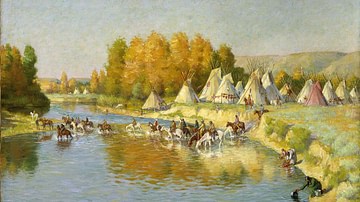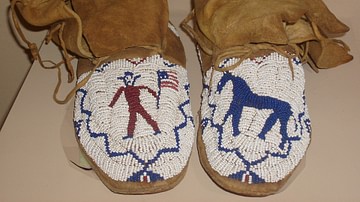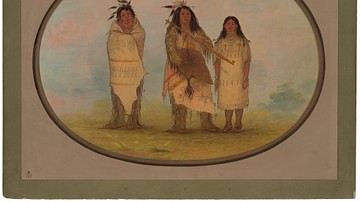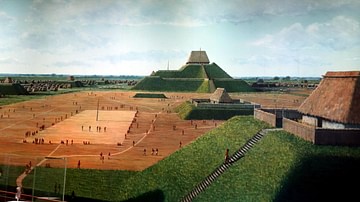The Origin of Medicine is a Cherokee story on the theme of balance and respect told from the point of view of the animals and plant life. When the animal world turns against humanity for their many abuses, the plants restore balance by siding with people. The story explains the origin of medicine while encouraging respect for nature.
The Cherokee nation originally lived in the regions of modern-day Alabama, Georgia, North Carolina, part of South Carolina, southern Tennessee, and Virginia. They inherited an agrarian lifestyle from the people of the so-called Mississippian Culture of the Mississippi River Valley, Ohio River Valley, and Tennessee River Valley, and so it is not surprising that one of their most popular stories credits plant life with humanity's salvation.
In the story, the animal world is driven to revolt against the abuses they have suffered at human hands and vow to destroy all the people and reclaim the lands they have lost. The war councils of the bears, deer, fish and reptiles, birds, insects, and small animals come to the same conclusion that humans have become too barbaric and intolerable and must be destroyed. Various methods are agreed upon, but it is finally decided that disease will be the most effective. At this point, the plants step in as humanity's defenders, promising their resources to ensure the people's survival.
Native American View of Nature
To the Cherokee and Native Americans generally, the natural world is understood as deserving of as much respect as any member of one's family. The world is recognized not only as a creation by a Higher Power but as a living entity and as sentient as any of the creatures that move upon it. All of the animals and plant life are recognized as worthy of the same level of respect one would show to fellow humans, and as the story illustrates, when this respect is not given, the world becomes imbalanced.
Modern-day anthropologists define the Native American belief system as "animism" – the understanding of all things as possessing a soul – but to Native Americans themselves, this is simply how the world is, without a need for labels or definitions. Just as human beings are animated by a spirit, so are animals and plants. Scholar Alan Taylor comments:
North American natives subscribed to "animism": a conviction that the supernatural was a complex and diverse web of power woven into every part of the natural world. Indians made no distinction between the natural and the supernatural…All living things belonged to a complex matrix that was simultaneously spiritual and material. Indeed, spirit power could be found in every plant, animal, rock, wind, cloud, and body of water. (18)
When people showed proper respect for the spirits of the inhabitants of the natural world, that respect was returned. As highlighted in the story, if a person had to kill a deer for food, the person should ask pardon of the deer and show it proper honor. If this was done, that honor reflected back upon the hunter, and balance was maintained. All the parts of any animal killed were always used so that there was no waste, further honoring the animal's sacrifice, and when a person died, their remains decomposed and became part of the earth which nourished the animals, and so the cycle of reciprocity was continued.
Danger of Imbalance
Problems arise when humans fail to show the proper level of respect for the natural world. In the story, humans and animals live together harmoniously until overpopulation drives the animals from their homes, and then, in order to feed the growing populace, humans begin hunting the animals without proper regard or respect. Animals become objectified. They are no longer seen as autonomous entities as entitled to life and personal freedom as any human but as sources of food and resources in the manufacture of clothing and shelter.
As soon as the people objectify the animals, the world becomes imbalanced. The story suggests that humans have claimed for themselves an authority over animals, which was never intended in the natural design. Although, in the story, the animals object to being hunted and killed for any reason, in Native American cultures generally, there was no problem with hunting and killing as long as it was for a reason and performed in accordance with well-established and respectful traditions.
In the story, these traditions have clearly been abandoned, and the animals are outraged. Each animal 'tribe' consults with its own kind to arrive at a solution to the 'human problem', and in the case of the bear tribe, this fails because they are not up to the task alone and are not asking others to help them. This separation of the animals, who all face a common enemy, is the first suggestion of imbalance in the natural world. The deer, fish, and reptiles all decide on individual courses of action they will pursue, and it is finally the birds, insects, and smaller animals that hit upon disease as the best plan in exterminating their tormenters. The story depicts the entire natural world diverted from a reciprocal community into a collective madness of vengeance owing to the imbalance introduced by humanity.
Although plant life cannot undo what has been decided upon by the animals, they can help restore the lost balance by pledging themselves to the cause of humanity. In making their vow, the story suggests, they also open themselves to communicating with humans directly, 'speaking' to the 'medicine man' or 'medicine woman' – the shaman – of a community who is open to hearing their voice. As the people respond, not only to the whispers of the plants but also with the respect due to the animal world and the new threats it poses, balance is restored.
Text
The following story is taken from Native American Myths & Legends, edited by J. K. Jackson.
In the old days, there was peace throughout the earth and mankind lived in friendship and harmony with the great beasts of creation. But as time progressed, the human race multiplied rapidly and became so large that the animals were forced to surrender their settlements and seek out new homes in the forests and deserts. Although cramped and unhappy, they did not complain too much, but embraced these changes with an open mind, hoping that mankind would now remain satisfied. Sadly, however, this was not the case and, within a short time, man began to equip himself with a variety of weapons – bows, arrows, axes, spears, and hooks – which he used to attack the beasts of the forests, slaughtering them for their flesh and valuable skins.
The animals, at first incredulous, soon became enraged by this show of bloodthirsty contempt and began to consider measures that would guarantee them their survival and safety. The bear tribe was the first to meet in council, presided over by White Bear, their chief. One after another, members of the tribe stood up and reported the appalling atrocities their families had suffered. Mankind had mutilated their bodies, devoured their flesh, skinned them to make superfluous clothing and displayed their severed heads on wooden stakes as trophies. There was only one way to deal with such hostility, it was unanimously agreed, and it involved wholesale war.
The bears sat down to deliberate their strategy more seriously, but as soon as someone asked about weapons, they all fell silent, knowing that humans had one distinct advantage over them in this respect.
"We should turn man's own instruments against him," announced one of the elder bears. "Let us go and find one of these bows, together with some arrows, and copy their design."
A messenger returned shortly afterwards with these objects and the group gathered round to examine them carefully. A strong piece of locust wood was called for by the chief and with this he constructed a bow. Then, one of the younger bears provided a piece of his gut for the string and soon the weapon was completed, ready for its first testing.
The strongest, most agile bear volunteered his services. He had little trouble drawing back the bow, but as soon as he attempted to let the arrow fly, his long claws became entangled in the string and the shot was ruined. He quickly realized that he would have to trim his claws, and when he had done this, he let a second arrow fly which hit its target successfully. Delighted with himself, he turned to face the chief, but White Bear did not appear at all pleased by the result.
"We need our claws to climb trees," he wisely proclaimed. "If we cut off our claws we will not be able to climb or hunt down prey and soon we would all starve together." And saying this, he ordered the group to scatter amongst the woods, instructing them to reappear before him when they had found a better solution.
The deer also held a similar council under their chief, Little Deer. After they had aired their grievances and lamented the death of their comrades, they came to a decision that, if any human hunter should attempt to slay one of them, without first asking suitable pardon, he would be struck down by rheumatism. Notice of this decision was sent out to all the villages of the Cherokee Indians nearby and the people were instructed what to do if ever necessity demanded that they kill one of the deer tribe.
So now, whenever a deer is hit by an arrow, Little Deer, who moves faster than the wind and can never be wounded, runs to the spot where the victim has fallen and, bending over the pool of blood, asks the spirit of the deer whether or not he has heard the hunter's plea for pardon. If the reply is 'yes', the hunter remains fit and well, but if the answer is 'no' then Little Deer tracks him to his home and strikes him down with rheumatism, transforming him into a helpless cripple.
The fishes and reptiles were the next to gather together to determine an appropriate punishment for their aggressors. They held council which lasted only a few minutes, where it was quickly decided that those who tortured or killed any of their species would be tormented by nightmarish visions of slimy serpents with foul breath twining around their limbs and throats, very slowly choking them to death. Or else, these brutal attackers would dream, day and night, of eating raw, decaying fish, causing them to refuse all food and to sicken and die as a result.
Finally, the birds, insects, and smaller animals held their own meeting, presided over by a grub-worm. Each creature, he announced, should come forward and state is point of view and, if the consensus was against mankind, the entire race should be put to death by the most cruel and painful means.
Frog was the first to leap forward and he delivered his tirade in a loud and angry voice.
"Something will have to be done to stop the spread of this human menace," he thundered. "See how they have kicked me and beaten me with sticks because they think I'm ugly. Now my back is covered with sores that will never disappear." And he pointed to the spots on his skin for everyone around him to examine.
Next, a group of birds hopped forward and began to condemn mankind for the way in which he ruthlessly set out to burn their feet, impaling them on a stick over a fire as soon as he had trapped them, and turning them slowly until their claws and feathers were singed black.
Others then followed with a string of complaints and criticisms so that, apart from the ground squirrel, who had seldom been a victim because of his tiny size, there was not one among the gathering who showed any restraint or compassion towards the human species. Hurriedly, they began to devise and name various lethal diseases to be released among the human population. As the list grew longer, the grub-worm shook with laughter and glee, until he suddenly fell over backwards and could not rise to his feet again, but had to wriggle off on his back, as he has done ever since that day.
Only the plants remained friendly towards man, and before long, every tree, shrub, and herb, down even to the wild grasses and mosses, agreed to provide some remedy for the diseases now hanging thick in the air.
"We will help mankind in his hour of need," each plant affirmed. "Every one of us shall assist in the struggle against sickness and disease and hope that, in return, the earth will be restored to order."
Even the weeds in the fields were endowed with healing properties and, in time, every tribe boasted a shaman, a great healer, capable of hearing the spirit-voices of the plants speaking to him whenever he was in doubt about a cure.
It was in this way that the very first medicine came into being, ensuring the survival of the human race which had come so perilously close to destruction.
Conclusion
As with all, or almost all, Native American stories, there is no dating The Origin of Medicine because the stories of the people were passed down orally from generation to generation until they were written down by white settlers or, in the case of the Cherokee, by their own people, in the 19th century. The original audience would have understood the importance of the message regarding respect and balance in all things, as these values were integral to the culture.
When the Euro-Americans took the land, however, they behaved like the people in the story who had lost sight of the harmony they had once known with the natural world. Like those in the story, the Euro-Americans objectified the land and the animals as sources of revenue. The Sioux shaman Black Elk, commenting on the white settlers' destruction of the buffalo in North America, notes:
The [white men] did not kill [the buffalo] to eat; they killed them for the metal that makes them crazy [money] and they took only the hides to sell. Sometimes they did not even take the hides, only the tongues; and I have heard that fire-boats came down the Missouri River loaded with dried bison tongues. You can see that the men who did this were crazy. (133)
Objectification of the natural world leads inevitably to abuse of that world. The Origin of Medicine is just as resonant today as when it was first composed hundreds of years ago, if not more so, as people continue to disrespect the natural world and deny that their actions have any long-term consequences for the planet.








